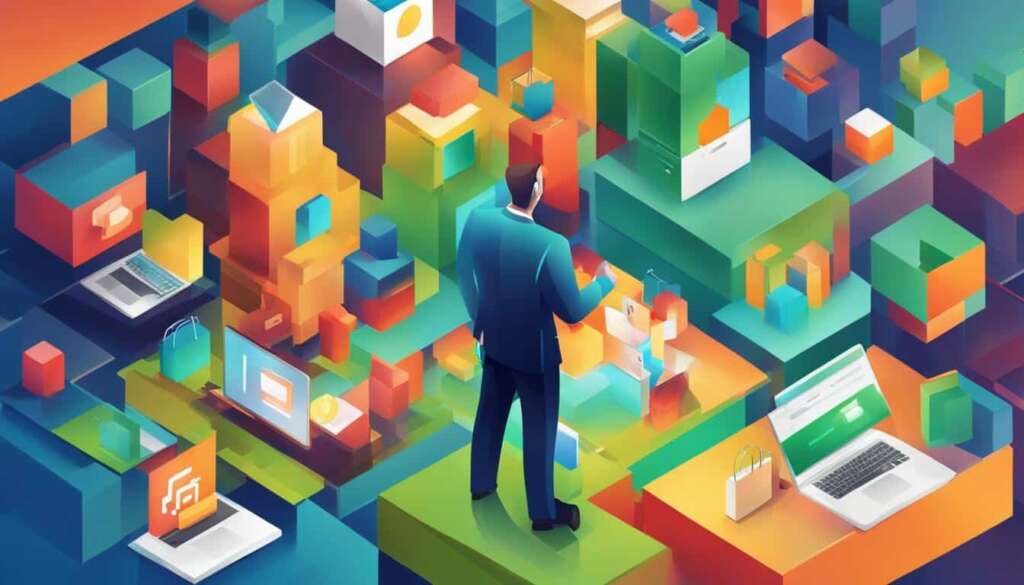Table of Contents
E-commerce, also known as electronic commerce, is the process of buying and selling goods and services over the internet. It involves the transmission of funds or data over electronic networks. The rise of e-commerce has transformed the way we shop and conduct business in the digital age.
There are different types of e-commerce transactions, including:
- Business-to-business (B2B): Transactions that occur between businesses, such as a manufacturer selling products to a retailer.
- Business-to-consumer (B2C): Transactions between businesses and individual consumers, such as online retail platforms like Amazon and eBay.
- Consumer-to-consumer (C2C): Transactions between individual consumers, such as buying and selling items on platforms like Etsy or eBay.
- Consumer-to-business (C2B): Transactions where consumers offer products or services to businesses, like freelancers providing services to companies.
In 2020, e-commerce accounted for approximately 15% of retail sales, showcasing its significant impact and potential for growth.
How E-commerce Works
E-commerce, with its streamlined process, allows customers to conveniently access online stores and engage in various transactions. Let’s dive into the inner workings of e-commerce, exploring the process and transactions involved.
When a customer decides to make a purchase, their web browser establishes communication with the server hosting the e-commerce website. By sending requests and receiving responses, the customer can navigate through the online store, browse a wide range of products and services, and ultimately place an order.
Once the customer initiates an order, data related to the purchase is transmitted to an order manager. This order manager acts as a central hub, connecting with different databases responsible for managing inventory levels, payment processing applications, and banks. This integration ensures the seamless flow of information, facilitating efficient order processing.
After the order data is validated and all necessary checks are completed, the customer receives a notification confirming their successful order placement. Simultaneously, the order details are transmitted to the warehouse or fulfillment department, which prepares the items for dispatch or service access.
E-commerce transactions can occur through various platforms. Online marketplaces such as Amazon and eBay provide a vast marketplace where businesses and individuals alike can conduct transactions. Additionally, software as a service (SaaS) tools and open-source platforms managed by companies offer tailored e-commerce solutions to meet specific business needs.
In summary, the e-commerce process involves customer access to online stores, browsing of products and services, order placement, communication with the order manager, validation and notification, and final preparations for product dispatch or service provision. Let’s explore the different types of e-commerce transactions in the next section.
E-commerce Process Overview
| Step | Description |
|---|---|
| 1 | Customer accesses the e-commerce website |
| 2 | Customer browses products and services |
| 3 | Customer places an order |
| 4 | Web browser communicates with the server hosting the website |
| 5 | Data related to the order is relayed to the order manager |
| 6 | Order manager communicates with databases managing inventory levels, payment processing applications, and banks |
| 7 | Order validation and confirmation |
| 8 | Customer receives notification of successful order placement |
| 9 | Order data is sent to the warehouse or fulfillment department |
| 10 | Preparation for product dispatch or service access |
Let’s dive deeper into the different types of e-commerce transactions in the next section.
Types of E-commerce
E-commerce encompasses different types of online transactions, catering to various business models and customer interactions. Understanding these distinct types can provide valuable insights into the diverse nature of electronic commerce.
B2B E-commerce
B2B e-commerce, or business-to-business e-commerce, involves transactions between businesses. In this type of online commerce, companies sell products or services to other businesses. B2B e-commerce is prevalent in industries such as manufacturing, wholesale, and distribution. It enables companies to streamline their procurement processes, reduce costs, and expand their market reach.
B2C E-commerce
B2C e-commerce, or business-to-consumer e-commerce, is the most widely recognized form of online retail. It involves businesses selling products or services directly to individual consumers. B2C e-commerce platforms like Amazon and eBay have become household names, offering a vast array of products accessible to customers from the comfort of their homes.
C2C E-commerce
C2C e-commerce, or consumer-to-consumer e-commerce, refers to transactions conducted between individual consumers. Popular examples of C2C platforms are eBay and Craigslist, where individuals can buy and sell goods directly to each other. C2C e-commerce provides a convenient avenue for individuals to monetize their pre-owned items or purchase second-hand goods at affordable prices.
C2B E-commerce
C2B e-commerce, or consumer-to-business e-commerce, is a relatively new concept where consumers offer products or services to businesses. This type of e-commerce is common in the gig economy, where freelancers and independent contractors provide specialized services to companies. Platforms like Upwork and Fiverr facilitate C2B transactions, allowing individuals to showcase their skills and expertise to potential employers.
| Type of E-commerce | Description |
|---|---|
| B2B E-commerce | E-commerce transactions between businesses |
| B2C E-commerce | E-commerce transactions between businesses and individual consumers |
| C2C E-commerce | E-commerce transactions between individual consumers |
| C2B E-commerce | E-commerce transactions where consumers offer products or services to businesses |
Each type of e-commerce has its own dynamics, advantages, and challenges. Understanding these distinctions is crucial for businesses and consumers alike, as it allows them to harness the full potential of e-commerce in today’s digital landscape.
Advantages and Disadvantages of E-commerce
E-commerce, or electronic commerce, offers numerous benefits as well as some drawbacks. Understanding these advantages and disadvantages is essential for businesses and consumers navigating the world of online transactions.
Benefits of E-commerce
- Around-the-clock availability: With e-commerce, customers can shop anytime, anywhere, allowing for greater convenience and flexibility.
- Quick access to products and services: Online platforms enable customers to find and purchase items with just a few clicks, streamlining the buying process.
- Wide selection: E-commerce provides access to a vast array of products from various sellers, expanding choices for consumers.
- Easy accessibility through online browsing: Customers can effortlessly browse through product catalogs, compare prices, and read reviews, facilitating informed purchasing decisions.
- Potential for international reach: E-commerce allows businesses to expand their customer base beyond geographic boundaries, tapping into global markets and increasing sales.
- Lower costs for businesses: Compared to traditional brick-and-mortar stores, e-commerce typically incurs lower overhead expenses, reducing operational costs.
- Personalization and product recommendations: E-commerce platforms leverage customer data to offer personalized experiences, including tailored product recommendations based on preferences and past purchases.
Drawbacks of E-commerce
- Limited customer service: Unlike physical stores, e-commerce often lacks face-to-face interactions, making it challenging to provide immediate assistance and resolve queries.
- Inability to touch and experience products: The virtual nature of e-commerce means customers cannot physically examine or try products before making a purchase, potentially leading to dissatisfaction.
- Wait times for shipping: Although e-commerce offers the convenience of doorstep delivery, customers may experience delays in receiving their orders, particularly for international shipments.
- Security concerns: Online transactions involve the exchange of sensitive data, raising concerns about data breaches, identity theft, and fraudulent activities.
Despite these challenges, e-commerce continues to flourish, revolutionizing the consumer experience and empowering businesses to reach a global audience.

Conclusion
E-commerce has revolutionized the way goods and services are bought and sold, reshaping the retail landscape. With its convenience, global reach, and cost savings, e-commerce has become a significant force in the business world.
Through various business models, such as B2B, B2C, C2C, and C2B, e-commerce caters to different types of transactions, facilitating seamless online interactions between businesses and consumers. The accessibility and wide range of products available online have made it easier for customers to find what they want, when they want it.
While e-commerce offers numerous advantages, such as the ability to shop anytime and anywhere, it also has its challenges. Limited customer service and the inability to physically interact with products before purchase are factors to consider. However, these drawbacks have not prevented the continuous growth and evolution of e-commerce.
As we look ahead, it is clear that e-commerce will continue to shape the future of retail and online commerce. With technological advancements and changing consumer behaviors, businesses must adapt and embrace e-commerce to remain competitive in the ever-evolving digital landscape.
FAQ
What is e-commerce?
E-commerce, short for electronic commerce, refers to the buying and selling of goods and services over the internet.
How does e-commerce work?
E-commerce operates through the internet, allowing customers to access online stores, browse products and services, and place orders.
What are the types of e-commerce?
E-commerce can be categorized into different types based on the parties involved in the online transactions, including B2B (business-to-business), B2C (business-to-consumer), C2C (consumer-to-consumer), and C2B (consumer-to-business).
What are the advantages and disadvantages of e-commerce?
E-commerce offers advantages such as around-the-clock availability, quick access to products, a wide selection of goods, and lower costs for businesses. However, it also has disadvantages such as limited customer service, inability to physically experience products before purchase, wait times for shipping, and security concerns.
What is the summary of e-commerce?
E-commerce has revolutionized the way goods and services are bought and sold, bringing convenience, global reach, and cost savings to businesses and consumers alike.







